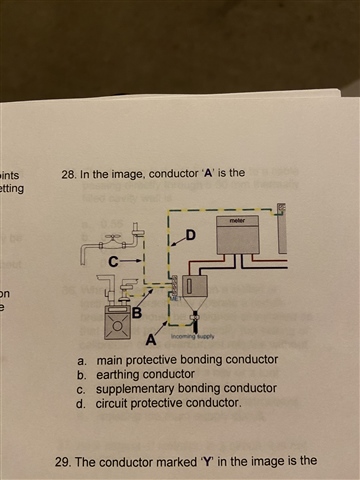 hi started to study for my 18th, wots you guys think the answer is, something tells me it’s different to wots on the answer sheet
hi started to study for my 18th, wots you guys think the answer is, something tells me it’s different to wots on the answer sheet
There are no exposed CPs to be connected.
There are ... downstream of the CU. The definition of cpc doesn't preclude that. In fact, without D being a cpc, the final circuit cpc's wouldn't be in contact with MET and by definition wouldn't be cpc's !
Circuit protective conductor (cpc). A protective conductor connecting exposed-conductive-parts of equipment to the main earthing terminal.
I did say this might be interesting.
If you don't like "main protective conductor", how about "main circuit protective conductor"
Neither are defined in BS 7671, although I guess 'main circuit protective conductor' is a 'circuit protective conductor' for the 'main circuit' - so it's a cpc ?
However, what if the CU is 16th Edn or earlier and is plastic? There are no exposed CPs to be connected.
But the supply circuit still needs an Earth - since it needs to provide that facility to downstream circuits - just like the c.p.c. in a socket circuit where the sockets are plastic and on plastic boxes (and with plastic faceplate screws or plastic cover caps if you insist). I've no problem calling it a c.p.c. even if were supplying a plastic CU that supplies an all insulated lighting circuit (c.p.c. run to all points, but no exposed-conductive-part to connect it to). Maybe the definitions could do with a bit of modernising though.
- Andy.
Of course - I have never said that the cable D could be omitted, but if the CU is non-conducting there are no exposed CPs in that circuit so the definition of a CPC does not fit well.
Actually we are quite happy with a CPC to an all plastic socket or fused spur that does not need it - but things that connect beyond do. I see this as the same, but clearly others do not ;-)
But I agree it is not a nice question - and we all know what the wire is for.
Mike.
Of course - I have never said that the cable D could be omitted, but if the CU is non-conducting there are no exposed CPs in that circuit so the definition of a CPC does not fit well.
Sorry - I didn't mean to suggest it could be omitted - merely that it still has that function even though the need for it is further downstream (or even if there's no need for it at all at present, and it's just included on the off chance that exposed-conductive-parts are added at a later date (last paragraph of 411.3.1.1)).
- Andy.
We're about to take you to the IET registration website. Don't worry though, you'll be sent straight back to the community after completing the registration.
Continue to the IET registration site